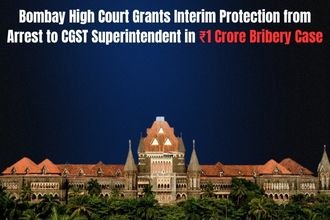In a landmark decision that underscores the judiciary’s careful balancing of legal rights and accountability, the Bombay High Court has granted interim protection from arrest to Abhishek Katiyar, a Superintendent in the Central Goods and Services Tax (CGST) department. Katiyar has been accused of demanding a bribe of ₹1 crore to settle an inquiry into alleged GST evasion by two private companies. Justice N R Borkar ruled that Katiyar will not be arrested until the next hearing scheduled for November 7, 2025, provided he fully cooperates with the ongoing investigation conducted by the Central Bureau of Investigation (CBI) and appears at the Anti-Corruption Branch in New Delhi on October 28 and 29.
Background of the Case
The legal proceedings stem from a complaint filed by Vivek Pratap Singh of the Directorate General of GST Intelligence (DGGI), Durgapur unit. The complaint alleges that Katiyar, along with a woman identified as Advocate Priyanka, repeatedly solicited bribes during an investigation into alleged tax evasion connected to multiple online betting platforms. Singh claimed that Katiyar demanded ₹1 crore to halt further legal and administrative actions against the companies involved.
Following the complaint, the CBI registered a First Information Report (FIR) and began a detailed investigation into the matter. During the proceedings, Katiyar’s defense argued that he was falsely implicated to protect other individuals, further highlighting that the FIR allegedly lacked specific provisions under the Prevention of Corruption Act.
The case has quickly drawn attention due to its potential implications for anti-corruption enforcement and the accountability mechanisms within India’s tax administration system.
Court’s Ruling and Conditions
Justice Borkar granted interim relief from arrest, a decision contingent upon Katiyar’s full cooperation with the investigation. The Court underscored that the order was temporary and emphasized the importance of balancing legal accountability with the protection of the accused’s rights.
The interim protection is not a dismissal or acquittal; rather, it ensures that the accused does not evade the investigation while guaranteeing that his constitutional rights are preserved. The Court made it clear that failure to comply with the stipulated conditions could result in immediate cancellation of the interim relief and potential arrest.
The ruling demonstrates the Court’s commitment to:
- Upholding the integrity of the investigative process.
- Protecting the rights of public servants under investigation.
- Ensuring fair legal proceedings without bias or undue haste.
Implications for Anti-Corruption Efforts
This case highlights ongoing challenges in India’s tax administration despite comprehensive reforms and the digitization of the GST framework. Incidents of bribery, corruption, and misconduct, such as those alleged against Katiyar, continue to emerge, highlighting the persistent need for vigilance and enforcement.
The involvement of the CBI signals the seriousness of allegations against public officials. It demonstrates the government’s resolve to enforce transparency and accountability, particularly in cases that involve senior bureaucrats or officials with substantial administrative responsibilities.
For legal practitioners and policymakers, the case is instructive for several reasons:
- Application of the Prevention of Corruption Act: How FIRs are drafted, procedural safeguards, and evidence requirements will influence how similar cases are handled in the future.
- Interim Protection Mechanisms: The order exemplifies how courts grant temporary protection to ensure due process, balancing investigative needs with rights guaranteed under the Constitution.
- Public Perception and Trust: Handling high-profile corruption cases with fairness is critical to maintaining public confidence in both the judiciary and administrative systems.
Legal Analysis
The ruling also serves as an important reference point in Indian jurisprudence regarding public servant accountability:
- Balancing Rights and Accountability: Interim protection illustrates judicial caution, ensuring that public servants are not prematurely punished while investigations continue.
- Judicial Oversight: The High Court’s decision reflects active oversight of investigative agencies to prevent procedural lapses.
- Precedent Setting: While interim, such rulings often influence the handling of similar high-profile corruption cases across India, especially concerning bureaucratic misconduct and bribery allegations.
Legal experts suggest that the outcome of this case could establish benchmarks for how courts balance investigative efficiency with constitutional rights, particularly in corruption-related matters involving senior officers.
Public and Media Reaction
The case has attracted widespread media attention, with discussions centered on:
- GST Administration Reforms: Public debates about corruption, bribery, and the efficacy of digital monitoring.
- Judicial Intervention: Media outlets have highlighted the Court’s measured approach, which protects individual rights while facilitating thorough investigation.
- Impact on Bureaucratic Behavior: Analysts suggest such rulings act as deterrents, encouraging bureaucrats to act transparently while being aware that accountability mechanisms are robust.
Broader Context
Corruption remains a key challenge in India’s bureaucratic and tax systems. The GST regime, implemented to unify indirect taxes and reduce evasion, has been generally successful but is not immune to malpractice. Cases like this highlight systemic vulnerabilities that need continuous oversight.
This ruling emphasizes:
- Judiciary as a Check on Executive Power: Courts are critical in ensuring investigations do not turn into harassment while maintaining accountability.
- Legal Protections for Accused Officials: Ensuring fairness prevents misuse of investigative powers, which could otherwise destabilize governance structures.
- Public Administration Transparency: Highlighting corruption cases publicly reinforces the message of zero tolerance for malfeasance.
Conclusion
The Bombay High Court’s decision to grant interim protection from arrest to CGST Superintendent Abhishek Katiyar is a landmark moment in India’s fight against corruption in public administration. The case exemplifies the delicate balance courts maintain between ensuring accountability and protecting the legal rights of accused public officials.
As the investigation continues, the legal community, policymakers, and the public will be keenly observing the case’s developments. Its outcome could have significant implications for future anti-corruption policies, the enforcement of the Prevention of Corruption Act, and procedural safeguards afforded to government officials.
Also Read



